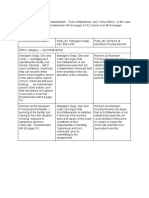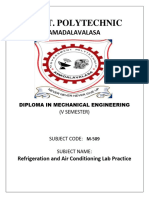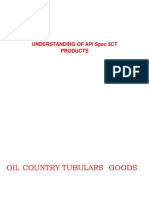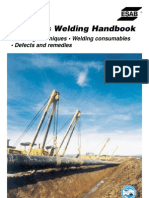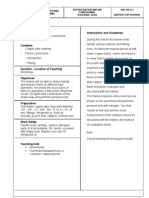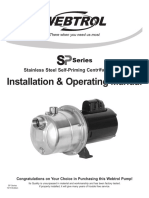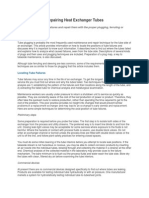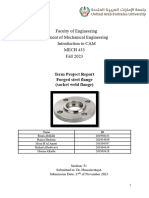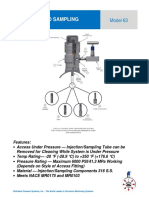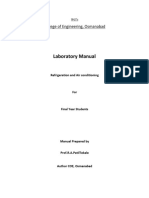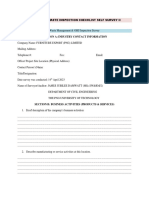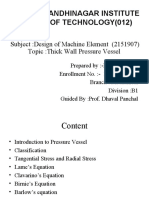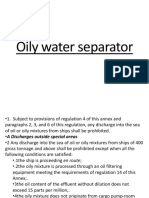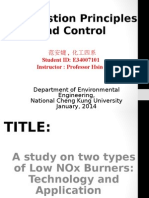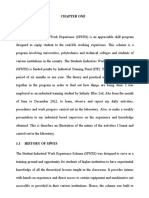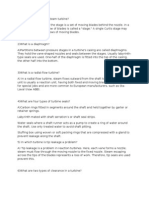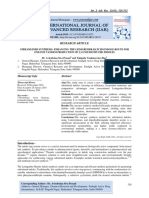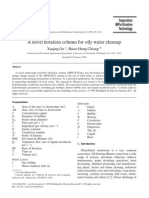Gas Flow System Laboratory SKN 4711: Title of Experiment
Gas Flow System Laboratory SKN 4711: Title of Experiment
Uploaded by
jamalasri8792Copyright:
Available Formats
Gas Flow System Laboratory SKN 4711: Title of Experiment
Gas Flow System Laboratory SKN 4711: Title of Experiment
Uploaded by
jamalasri8792Original Title
Copyright
Available Formats
Share this document
Did you find this document useful?
Is this content inappropriate?
Copyright:
Available Formats
Gas Flow System Laboratory SKN 4711: Title of Experiment
Gas Flow System Laboratory SKN 4711: Title of Experiment
Uploaded by
jamalasri8792Copyright:
Available Formats
GAS FLOW SYSTEM LABORATORY SKN 4711
Title of Experiment STEEL PIPE THREADING
DEPARTMENT OF GAS ENGINEERING FACULTY OF CHEMICAL & NATURAL RESOURCES ENGINEERING UNIVERSITI TEKNOLOGI MALAYSIA
Gro up Group Leader 1. Members 2. 3. 4. Technicians / Teaching Assistants
STEEL PIPE THREADING
INTRODUCTION
Threading is a process to make thread on pipe using pipe threading machines. Pipe thread is a spiral ridge on the end of a pipe that enables pipes to be joined together. For male fittings, pipe thread appears on the outer diameter of the pipe; if female, the pipe thread appears on the inner diameter. By rotating a male pipe end into a female pipe thread, the two fittings become joined. Since male and female pipe thread must align successfully to form a connection, manufacturers follow pipe thread industry standards. The two main pipe thread standards used in gas reticulation industries are the National Pipe Thread (NPT) which is a US standard for tapped thread and the BSPT (British Standard Pipe Taper Thread) which is a British standard for tapped thread, whose diameter increases or decreases along the length of the thread. NPT and BSPT are a tapered pipe thread that can make a close-fitting wet seal. There are also another standard for thread. National Standard Free-Fitting Straight Mechanical Pipe Thread (NPSM), a US standard and BSPP (British Standard Pipe Parallel Thread ), which have a constant diameter. NPSM and BSPP are a straight pipe thread that only forms a mechanical seal. When joining NPT or BSPT tapered pipe thread to make a leak-proof seal, professionals recommend using a sealer such as polytetrafluoroethylene (PTFE) pipe thread tape. PTFE, more commonly known as Teflon, is also the name of the best known brand of sealing tape. Tape should be wound tight around the male pipe threads, running in the same direction as the lead thread so that the turning motion of joining the pipes follows the tape's winding direction. Sealing tape makes it easy to drive the male pipe deeper by allowing the threads to slip past one another, while filling minute gaps to prevent seepage. Pipe thread tape also makes it easier to disassemble the joint later, if need be, by reducing thread galling, or the tendency of some types of pipe threads to stick together over time. LEARNING OBJECTIVES At the end of this module, students will be able to 1. 2. 3. 4. Describe types of thread Identify the threading machine and its components Perform the threading process Perform the threading steel pipe jointing
EQUIPMENT
Picture 1:
Steel Pipe Threading Machine
Feeds crew handle
Pipe Cutter
Die Head Die Pipe Reamer Cutting oil tank Power Vise
Foot Switch
Carriage
ON-OFF (control) switch
THREADING PROCEDURE Important Note: Prior to carrying out the threading procedure, you are required to perform equipment risk analysis and fill up a laboratory safety assessment form. Pipe cutting 1. 2. 3. 4. With reamer and die head in their UP position, place the cutter over the pipe. Turn the carriage to line up with the cutter wheel to cut-off mark (6 in. of pipe). With control switch in the close position, step on the foot switch and tighten the feed screw handle. Turn the feed screw handle until all cut-off is completed.
5.
Release the foot switch. Turn the machine off and return the cutter to its up position.
Pipe reaming 1. 2. 3. 4. With cutter and die head in their up position, swing the reamer into its operating position. With the control switch in the close position step on the foot switch and feed carriage towards the pipe. With slight carriage pressure feed reamer to achieve the desired ream. Release the foot switch, switch the machine off and return the reamer to it up position.
Pipe threading 1. 2. 3. 4. 5. 6. 7. 8. 9. With control switch in close position and all tools in their up position step on foot switch. Lower die head and oil will flow through head and onto dies. Feed die head towards pipe with carriage. Apply slight pressure to carriage until 3 to 4 threads have been cut. Release carriage. When the treading operation is complete, release foot switch. With machine is switched off return all tools to their up position. Turn the control switch to open position. Depress foot switch and machine will release the pipe. Release foot switch, turn control switch to the off position and remove pipe from machine.
PRACTICAL ASSIGMENT 1. 2. 3. Cut 6 in of pipe NPS using treading machine. Ream the pipe and make thread on one side of the pipe. How many threads per 1 in (25.4 mm) per size of pipe? Cut 6 in of pipe NPS 2 using treading machine. Ream the pipe and make thread on one side of the pipe. How many threads per 1 in (25.4 mm) per size of pipe? Sketch and describe the shape of your thread. - Starting thread (4 threads from unthreaded pipe) - 2 threads after starting thread - threads after 6 threads from unthreaded pipe - how many good thread ? Screw both of your samples into 90 elbow and get the end to end measurement. Make thread to another end of your sample. Screw you sample into 90 elbow both end and get the center to center measurement. State and explain any difference and similarity between these two measurements. Give your conclusion.
4. 4. 5. 6. 7.
You might also like
- Automotive Machining: A Guide to Boring, Decking, Honing & MoreFrom EverandAutomotive Machining: A Guide to Boring, Decking, Honing & MoreRating: 4.5 out of 5 stars4.5/5 (11)
- Methodology For Stressing of PSC GirdersDocument8 pagesMethodology For Stressing of PSC GirdersHegdeVenugopal100% (3)
- Pipe BendsDocument23 pagesPipe BendsabhisheknharanghatNo ratings yet
- Bow Thruster Installation InstructionsDocument9 pagesBow Thruster Installation InstructionsRovert AlonzoNo ratings yet
- Performance Exhaust Systems: How to Design, Fabricate, and Install: How to Design, Fabricate, and InstallFrom EverandPerformance Exhaust Systems: How to Design, Fabricate, and Install: How to Design, Fabricate, and InstallRating: 4 out of 5 stars4/5 (8)
- 8.12 RNA Transcription WorksheetDocument2 pages8.12 RNA Transcription WorksheetAmor Reyes EngNo ratings yet
- EG2401 - Tutorial 1 - t507 - A0127826YDocument3 pagesEG2401 - Tutorial 1 - t507 - A0127826YSad Fate100% (1)
- Safety h2s Training PresentationDocument18 pagesSafety h2s Training Presentationayman mohamed100% (1)
- M3 - U6 - Pipe Threading and TestingDocument25 pagesM3 - U6 - Pipe Threading and TestingAfonso BuenoNo ratings yet
- National Pipe ThreadDocument10 pagesNational Pipe ThreadLodyNo ratings yet
- Method Statement For Fab of Pipework and FittingsDocument13 pagesMethod Statement For Fab of Pipework and FittingsAllan EscobarNo ratings yet
- Govt. Polytechnic: AmadalavalasaDocument58 pagesGovt. Polytechnic: AmadalavalasaPraveen SingupurapuNo ratings yet
- Manual de Doblez TubingDocument76 pagesManual de Doblez TubingJose F. Mandujano100% (1)
- Thread TypeDocument4 pagesThread Typevikram_007No ratings yet
- ESAB - PipelinesDocument65 pagesESAB - PipelinesLigia114100% (2)
- Percentage Wall Reduction Is The Most FrequentlyDocument4 pagesPercentage Wall Reduction Is The Most Frequentlysanketpavi21No ratings yet
- API Spec 5CT IntroductionDocument37 pagesAPI Spec 5CT IntroductionChandrasekhar Sonar100% (2)
- PDMSDocument39 pagesPDMSprathikNo ratings yet
- PEM ManualDocument52 pagesPEM Manualagkrishnaroop007No ratings yet
- Pipe WorkDocument12 pagesPipe WorkSudheepNo ratings yet
- Condeser Tubing and Removal, DocDocument6 pagesCondeser Tubing and Removal, Docdebu1985No ratings yet
- Correct Expansion of Heat Exchanger - Boiler Tubes PDFDocument4 pagesCorrect Expansion of Heat Exchanger - Boiler Tubes PDFعزت عبد المنعمNo ratings yet
- Pipelines Welding HandbookDocument64 pagesPipelines Welding HandbookSixto GerardoNo ratings yet
- Topic Instructions and GuidelinesDocument16 pagesTopic Instructions and GuidelinesfraluleiNo ratings yet
- 63 Injection Sampling AssembliesDocument4 pages63 Injection Sampling AssembliesAbdul Hannan NazeerNo ratings yet
- Greenlee Dobladora de TubosDocument16 pagesGreenlee Dobladora de TuboswilfredoNo ratings yet
- WEBTROL SP Series Self-Priming Centrifugal PumpDocument8 pagesWEBTROL SP Series Self-Priming Centrifugal PumpSilvan ZupancNo ratings yet
- Case Study of Core and Pluge PreparationDocument9 pagesCase Study of Core and Pluge PreparationSpeculeNo ratings yet
- Restek Gas SamplingDocument4 pagesRestek Gas SamplingtomysetiyadiNo ratings yet
- How To Build A Fuel LineDocument15 pagesHow To Build A Fuel LineMech Engr100% (1)
- Maintaining and Repairing Heat Exchanger TubesDocument14 pagesMaintaining and Repairing Heat Exchanger TubesMicheal Brooks100% (1)
- Threads and Thread Cutting Operations: Arul R ApmechDocument22 pagesThreads and Thread Cutting Operations: Arul R ApmecharulsivagiriNo ratings yet
- Stub Onin ConnectionsDocument4 pagesStub Onin ConnectionsMehman NasibovNo ratings yet
- Threaded Piping: Carbon Steel Threaded Piping. Calculation of Man Hours with ExamplesFrom EverandThreaded Piping: Carbon Steel Threaded Piping. Calculation of Man Hours with ExamplesNo ratings yet
- Pneumatic Fittings Push in FittingsDocument7 pagesPneumatic Fittings Push in FittingsSiddharth GuptaNo ratings yet
- How To Thread PipeDocument9 pagesHow To Thread Pipenurlisa khaleedaNo ratings yet
- Serbco WP Training Manual For PPR Pipes and FittingsDocument16 pagesSerbco WP Training Manual For PPR Pipes and FittingsDewald Tjatjarag BurzynskiNo ratings yet
- Installation, Operation & Maintenance Manual For Flow MeterDocument8 pagesInstallation, Operation & Maintenance Manual For Flow MeteranakarNo ratings yet
- Cam Projectt.Document16 pagesCam Projectt.fu MozaNo ratings yet
- Selecting and Measuring Pipe & Fittings: Thread Type CompatibilityDocument1 pageSelecting and Measuring Pipe & Fittings: Thread Type CompatibilityITLHAPNNo ratings yet
- Installation Checklist For The Petroplas Piping System (Page 1 of 2)Document2 pagesInstallation Checklist For The Petroplas Piping System (Page 1 of 2)Sami ThirunavukkarasuNo ratings yet
- Pipe Threads: The Two Main Pipe Thread Standards Are As FollowsDocument2 pagesPipe Threads: The Two Main Pipe Thread Standards Are As Followssushant shirsatNo ratings yet
- Flare Joints in RacDocument7 pagesFlare Joints in RacRay NamuNo ratings yet
- Piping Inspector Questions 1Document6 pagesPiping Inspector Questions 1Badiuzzama786100% (1)
- Detalle Instalacion Punto de InyeccionDocument4 pagesDetalle Instalacion Punto de InyeccionRomner CordovaNo ratings yet
- AbstractDocument6 pagesAbstractVaibhav ShetiyaNo ratings yet
- Pertanyaan Seputar PipingDocument7 pagesPertanyaan Seputar PipingChandra Asiah WNo ratings yet
- Laboratory Manual: College of Engineering, OsmanabadDocument47 pagesLaboratory Manual: College of Engineering, OsmanabadEngr Ali RazaNo ratings yet
- Flange and GasketDocument35 pagesFlange and Gasketmackoi BalaresNo ratings yet
- 卧式离心泵说明书英文(大连双龙)Document16 pages卧式离心泵说明书英文(大连双龙)kamal arabNo ratings yet
- Titan Model R Series Pipe Driver and RemoverDocument2 pagesTitan Model R Series Pipe Driver and RemoverNguyen CuongNo ratings yet
- Fluid Power Fluid Power Equipment Tutorial - Pipe Work: Outcome 2Document12 pagesFluid Power Fluid Power Equipment Tutorial - Pipe Work: Outcome 2cataiceNo ratings yet
- Steam Turbines A Book of Instruction for the Adjustment and Operation of the Principal Types of this Class of Prime MoversFrom EverandSteam Turbines A Book of Instruction for the Adjustment and Operation of the Principal Types of this Class of Prime MoversRating: 5 out of 5 stars5/5 (2)
- Linotype Manual: Giving Detailed Instructions of the Proper Adjustment and Care of the LinotypeFrom EverandLinotype Manual: Giving Detailed Instructions of the Proper Adjustment and Care of the LinotypeNo ratings yet
- High Performance Fasteners and Plumbing: A Guide to Nuts, Bolts, Fuel, Brake, Oil and Coolant Lines, Hoses, Clamps, Racing Hardware and Plumbing TechniquesFrom EverandHigh Performance Fasteners and Plumbing: A Guide to Nuts, Bolts, Fuel, Brake, Oil and Coolant Lines, Hoses, Clamps, Racing Hardware and Plumbing TechniquesNo ratings yet
- Bolted Flanged Joint: Flanges, Studs & Gaskets. Recommended Practices for the Assembly of a Bolted Flange Joint.From EverandBolted Flanged Joint: Flanges, Studs & Gaskets. Recommended Practices for the Assembly of a Bolted Flange Joint.No ratings yet
- Wood Turning - The Lathe and Its Accessories, Tools, Turning Between Centres Face-Plate Work, Boring, PolishingFrom EverandWood Turning - The Lathe and Its Accessories, Tools, Turning Between Centres Face-Plate Work, Boring, PolishingNo ratings yet
- Estimator's Piping Man-hours Tool: Estimating Man-hours for Carbon Steel Process Piping Projects. Manual of Man-hours, ExamplesFrom EverandEstimator's Piping Man-hours Tool: Estimating Man-hours for Carbon Steel Process Piping Projects. Manual of Man-hours, ExamplesNo ratings yet
- Macramé for Beginners and Beyond: 24 Easy Macramé Projects for Home and GardenFrom EverandMacramé for Beginners and Beyond: 24 Easy Macramé Projects for Home and GardenRating: 4.5 out of 5 stars4.5/5 (8)
- Poly Etch 907 SDSDocument15 pagesPoly Etch 907 SDSmanish_keswani01No ratings yet
- Industrial Waste Inspection Checklist Self Survey Ii - 124743Document10 pagesIndustrial Waste Inspection Checklist Self Survey Ii - 124743James DamwattNo ratings yet
- Coordination Chemistry Reviews: Hadi Samadian, Hassan Maleki, Zahra Allahyari, Mehdi JaymandDocument30 pagesCoordination Chemistry Reviews: Hadi Samadian, Hassan Maleki, Zahra Allahyari, Mehdi JaymandCosmy CosminaNo ratings yet
- Lames Equation & Justification PDFDocument14 pagesLames Equation & Justification PDFjamil voraNo ratings yet
- Pid of A Piping SystemDocument4 pagesPid of A Piping SystemBandaluppi VenkateshNo ratings yet
- Wire Shelves SeriesDocument11 pagesWire Shelves SeriesKumar RaoNo ratings yet
- Common Pharma Interview Questions For FreshersDocument6 pagesCommon Pharma Interview Questions For Freshersrameshwar9595kNo ratings yet
- Bhopal Gas Tragedy Causes, Effects and Aftermath - GeeksforGeeksDocument1 pageBhopal Gas Tragedy Causes, Effects and Aftermath - GeeksforGeeksmxdczc5yxzNo ratings yet
- Oily Water SeparatorDocument24 pagesOily Water Separatormodisunami100% (1)
- Data Sheet LM301H CRI90 Rev.2.2Document22 pagesData Sheet LM301H CRI90 Rev.2.2HdhdjdNo ratings yet
- NOTOC-When To IssueDocument2 pagesNOTOC-When To IssueRAVC15No ratings yet
- Lecture 3: Design Consideration of DriersDocument6 pagesLecture 3: Design Consideration of DriersachalNo ratings yet
- Safety Data Sheet: Bunker C Fuel (Superior)Document10 pagesSafety Data Sheet: Bunker C Fuel (Superior)Lindsey BondNo ratings yet
- Full Black BookDocument117 pagesFull Black BookSheila DhengaleNo ratings yet
- Combustion Principles and ControlDocument32 pagesCombustion Principles and ControlThalia de la FuenteNo ratings yet
- Contoh Report PMDocument29 pagesContoh Report PMmuhammad addinNo ratings yet
- Umakor Maxwell It ReportDocument46 pagesUmakor Maxwell It ReportChinyereugo OkikeNo ratings yet
- Steam Turbine QuestionsDocument56 pagesSteam Turbine QuestionsNivas Ssv67% (3)
- General Science Model ExamDocument4 pagesGeneral Science Model Examdinasamsonk100% (2)
- Turkish CrystallograDocument23 pagesTurkish CrystallograPutra ArowachNo ratings yet
- 5198 - Renolin Hydraulic OilsDocument8 pages5198 - Renolin Hydraulic Oilsrahman12No ratings yet
- Acid, Base, and SaltDocument12 pagesAcid, Base, and SaltTamoghna DeyNo ratings yet
- Streamlined Synthesis: Enhancing The Leimgruber-Batcho Indole Route For One-Pot Tandem Production of 2,3-Unsubstituted IndolesDocument5 pagesStreamlined Synthesis: Enhancing The Leimgruber-Batcho Indole Route For One-Pot Tandem Production of 2,3-Unsubstituted IndolesIJAR JOURNALNo ratings yet
- Tube-To-tubesheet Joints - ASME (Mechanical) Code Issues - Eng-TipsDocument4 pagesTube-To-tubesheet Joints - ASME (Mechanical) Code Issues - Eng-Tipsagniva dattaNo ratings yet
- Chemistry Book PDFDocument583 pagesChemistry Book PDFDarwesh WazirNo ratings yet
- Zhejiang Marco Valve Co., Ltd. IntroductionDocument48 pagesZhejiang Marco Valve Co., Ltd. Introductionesmeralda diazNo ratings yet
- A Novel Flotation Column For Oily Water CleanupDocument11 pagesA Novel Flotation Column For Oily Water CleanupmarcelohilarioNo ratings yet







